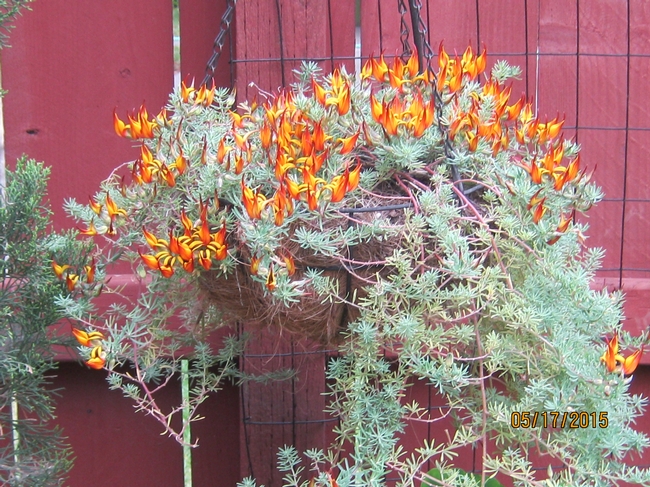- Author: Susan P Croissant
Parrot's Beak
Parrot's beak (Lotus maculatus), aka Coral Gem/Pelican's Beak. Totally unrelated to the aquatic water lily (Lotus) Nelumbo lutea, N. nucifera. L. maculatus resembles L. berthelotti, both native to the Canary and Cape Verde Islands, with similar growing requirements. Though severely endangered on their native islands, they survive in cultivation.
This herbaceous, tender perennial (or warm weather annual vine) grows 8-12" high and is covered with silvery gray leaves and long, trailing stems up to 2-3 feet. 'Gold Flash' has bright yellow flowers with striking orange-red markings. 'Amazon Sunset' has bright orange red flowers. The pea-like flowers bloom in spring and early summer. L. berthelotti has 1" scarlet blooms in summer.
Can be effective as a ground cover cascading over walls and rocks (space 2-feet apart). But is BEST in a hanging container/basket as it might become an invasive, noxious weed. As a hanging plant, it is a striking addition to the garden. I noted this specimen immediately when I entered Gabriel's garden (Vallejo Garden Tour 2015) where he incorporates tropical and Mediterranean species.
In Gabriel's garden, Parrot's Beak hangs off the western fence in a corridor with other tropicals, while the eastern corridor holds Mediterranean plants. As it dislikes hot summer temperatures and may stop blooming, placement is important. Not only temperature-wise but also water-wise. This plant is best with even moisture. Too much or too little water causes foliage to drop. Further, where drainage is poor, it suffers root rot--hates soggy roots. Thus, a hanging basket (say, moss or coco-fiber) works well. As does fertile soil. It can also be grown indoors, offering year-round greenery and seasonal color. Try a south-facing window and move if it proves too hot.
Blooms better when nights remain warm. Dies back in cold weather. Pinching stem ends will promote branching. Prune dead, diseased, dying or damaged branches with sharp pruning shears and dispose of the removed branches. Feed every 2 weeks during spring and summer with water-soluble, all-purpose fertilizer or apply slow-release fertilizer once a year at the beginning of spring.
Propagation from stem cuttings or seeds indoors about 8-10 weeks prior to last front (usually will not produce flowers the first year). Examine regularly for spider mites, aphids, mealy bugs. If found, coat foliage and branches with horticulture oil or insecticide soap on a calm day when temperatures stay below 90°.







Wendy